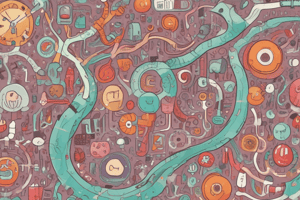Podcast
Questions and Answers
What does metabolism represent?
What does metabolism represent?
- Chemical changes converting substrates into end products (correct)
- Digesting macromolecules into monomeric precursors
- Converting nutrients into energy-rich molecules
- Obtaining solar energy through intermediary metabolism
Which metabolic activity involves capturing solar energy or degrading energy-rich nutrients?
Which metabolic activity involves capturing solar energy or degrading energy-rich nutrients?
- Polymerizing monomeric precursors into macromolecules
- Converting nutrient molecules into the cell's own characteristic molecules
- Obtaining chemical energy through metabolic pathways (correct)
- Synthesizing biomolecules required for specialized cellular functions
What is the main role of multienzyme systems in metabolism?
What is the main role of multienzyme systems in metabolism?
- Conversion of organic forms into carbon dioxide
- Cooperation in metabolic pathways to achieve cellular functions (correct)
- Degradation of biomolecules
- Energy capture from the environment
Which classification is based on the carbon requirement of an organism?
Which classification is based on the carbon requirement of an organism?
What is the distinction between catabolism and anabolism in metabolic processes?
What is the distinction between catabolism and anabolism in metabolic processes?
In metabolism, what do autotrophs primarily utilize as a carbon source?
In metabolism, what do autotrophs primarily utilize as a carbon source?
What is the primary function of the duodenum?
What is the primary function of the duodenum?
Which of the following is NOT a characteristic of gastric juice secreted by the gastric mucosa?
Which of the following is NOT a characteristic of gastric juice secreted by the gastric mucosa?
Which of the following enzymes is NOT involved in the digestion of dietary fat?
Which of the following enzymes is NOT involved in the digestion of dietary fat?
What are the end products of aerobic catabolism?
What are the end products of aerobic catabolism?
Which of the following statements is true about the digestive enzymes in saliva?
Which of the following statements is true about the digestive enzymes in saliva?
What is the role of complex metabolic regulation in maintaining a constant cellular environment?
What is the role of complex metabolic regulation in maintaining a constant cellular environment?
Which of the following is NOT a type of chemotroph based on the energy source it utilizes?
Which of the following is NOT a type of chemotroph based on the energy source it utilizes?
Which of the following statements about obligate aerobes and obligate anaerobes is correct?
Which of the following statements about obligate aerobes and obligate anaerobes is correct?
Which of the following statements accurately describes the difference between catabolism and anabolism?
Which of the following statements accurately describes the difference between catabolism and anabolism?
Which of the following statements accurately describes the metabolic map representation shown in the image?
Which of the following statements accurately describes the metabolic map representation shown in the image?
Which of the following statements accurately describes the multi-enzyme systems shown in the image?
Which of the following statements accurately describes the multi-enzyme systems shown in the image?
Which of the following statements accurately describes the role of salivary $\alpha$-amylase (ptyalin) in digestion?
Which of the following statements accurately describes the role of salivary $\alpha$-amylase (ptyalin) in digestion?




